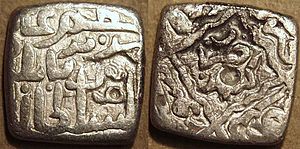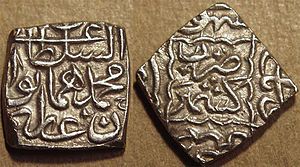- Mirza Muhammad Haidar Dughlat
-
Mirza Muhammad Haidar Dughlat (1499 or 1500–1551) was a Chagatai Turko-Mogol military general, ruler of Kashmir, and a historical writer. He was a Turkic speaking Dughlat prince who wrote in Persian[1] and Chagatai languages. Prince Haider was a first cousin of Prince Zahir (later Emperor Babur).
Contents
Life
He first campaigned in Kashmir in 1533, on behalf of Sultan Said Khan, of Kashgar. He drove out Kamran, second son of Babur.[2] However, he did not stay long in Kashmir, leaving after making a treaty with the local sultan and striking coins in the name of Said Khan. His short stay may have had something to do with the fact that Said Khan died in that year.
He returned in 1540, fighting for the Mughal Emperor Humayun,[3] first son of Babur, this time for a military takeover at the invitation of one of the two rival factions that continually vied for power in Kashmir. This was shortly after Humayun's 1540 defeat at the battle of Kanauj, where Dughlat was also on the losing side. He had also attacked Tibet through Ladakh but had failed.[4] Arriving in Kashmir, Haidar installed as sultan the head of the Sayyid faction, Nazuk. In 1546, after Humayun recovered Kabul, Haidar removed Nazuk Shah and struck coins in the name of the Mughal emperor.[5] He died in 1550. He lies buried in the Gorstan e Shahi in Shrinagar, Kashmir, India.
Works
His historical work Tarikh-i-Rashidi ( History of Rashid ) is a personal memoir combined with a Central Asian history. Mirza Muhammad Haidar devoted this extensive work, written in Kashmir from 1541 to 1546 in two volumes, to contemporary ruler of Kashgaria Abdurashid Khan, son of Sultan Said Khan (descendant of first Moghul Khan Tughluk Timur Khan, grandson of Duwa Khan, great great grandson of Chagatai Khan, second son of Chengiz Khan), founder of Saidiya state in Kashgaria in 1514 with active and decisive support of author's uncle Sayyid Muhammad Mirza. It was translated into English in 1895 by Ney Elias and Edward Denison Ross. Among other events, the Tarikh-i-Rashidi describes the founding of the Kazakh Khanate in 1465 and Muhammad Haidar Dughlat's personal encounter with one of the early Kazakh rulers, namely Kasym Khan.
Family
He belonged to the family of hereditary rulers of Kashgaria - dughlat Amirs. His father was Muhammad Hussain Mirza Kurkan (he was married to Khub Nigar Khanim, daughter of Yunus Khan), son of Muhammad Haidar Mirza Kurkan (he was married to Daulat Nigar Khanim, daughter of Esen Buqa Khan), son of Amir Sayyid Ali Kurkan (he was married to Uzun Sultan Khanim, sister of Vais Khan), son of Amir Sayyid Ahmad, son of Amir Hudaidad, who is said to have raised to khanship six of the Moghul Khans (Khizir Khoja (1389–1399), Shama-i-Jahan (1399–1408), Muhammad (1408–1416), Nakhsh-i- Jahan (1416–1418), Shir Muhammad (1418–1425), Vais (1418–1428)), son of Amir Pulaji, who raised to the khanship a young, 18- years old, Tughluk Timur Khan ( first Moghul Khan ), in 1347, having brought him from Ili to Aksu and declared him to have been the grandson of Duwa Khan. Amir Pulaji was a descendant of Dughlat Tarkhan Babdaghan, who was granted the country Mangalai Suyah (Faced to Sun) or Kashgaria by Chagatai Khan, second son of Chengiz Khan, in 1219 or 1220.
His mother was Khub Nigar Khanim, third daughter of Yunus Khan by Isan Daulat Begum, and a younger sister of Kutluk Nigar Khanim, mother of Babur. Mirza Muhammad Haidar governed Kashmir from 1540 to 1551,[6] when he was killed in battle.
References
- Mansura Haidar (translator) (2002), Mirza Haidar Dughlat as Depicted in Persian Sources
Notes
- ^ René Grousset, The Empire of the Steppes: A History of Central Asia (1970 translation), p. 497.
- ^ Mughal Empire 1526-1707 by Sanderson Beck
- ^ Shahzad Bashir, Messianic Hopes and Mystical Visions: The Nurbakhshiya Between Medieval And Modern Islam (2003), p. 236.
- ^ Bell, Charles (1992). Tibet Past and Present. Motilal Banarsidass Publ.. p. 33. ISBN 8120810481. http://books.google.co.uk/books?id=RgOK7CgFp88C&printsec=frontcover&dq=tibet#v=onepage&q=&f=false.
- ^ Stan Goron and J.P. Goenka: The Coins of the Indian Sultanates, New Delhi: Munshiram Manoharlal, 2001, pp. 463-464.
- ^ List of Rulers: South Asia | Thematic Essay | Timeline of Art History | The Metropolitan Museum of Art
External links
Categories:- 1551 deaths
- Dughlats
- Year of birth uncertain
- Historians of Central Asia
- Mughal Empire
Wikimedia Foundation. 2010.


